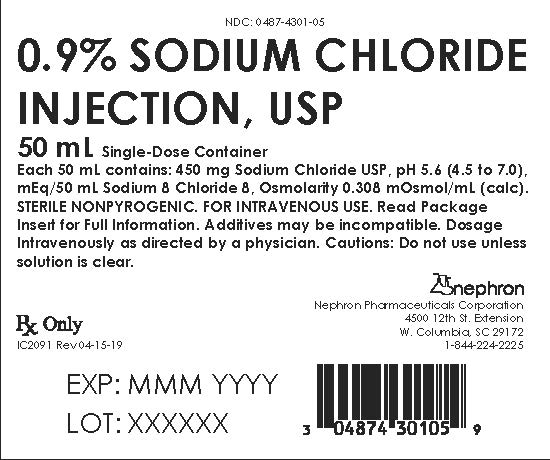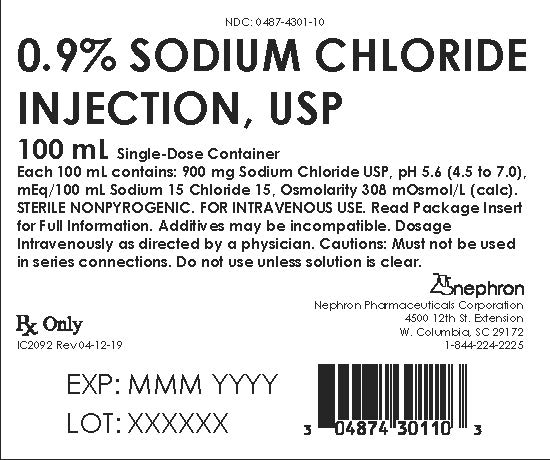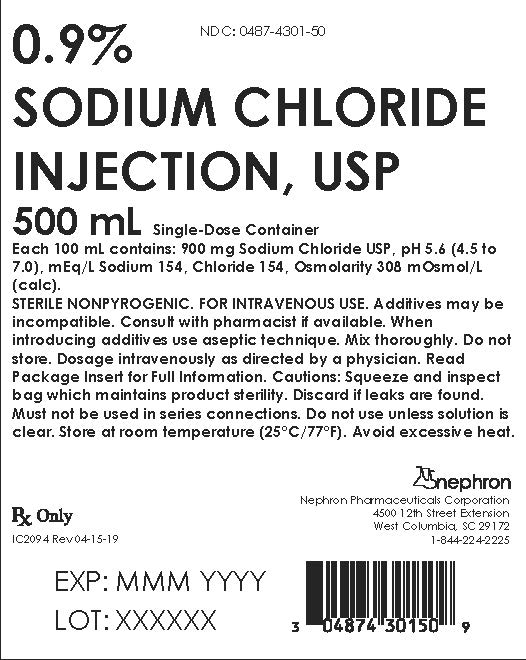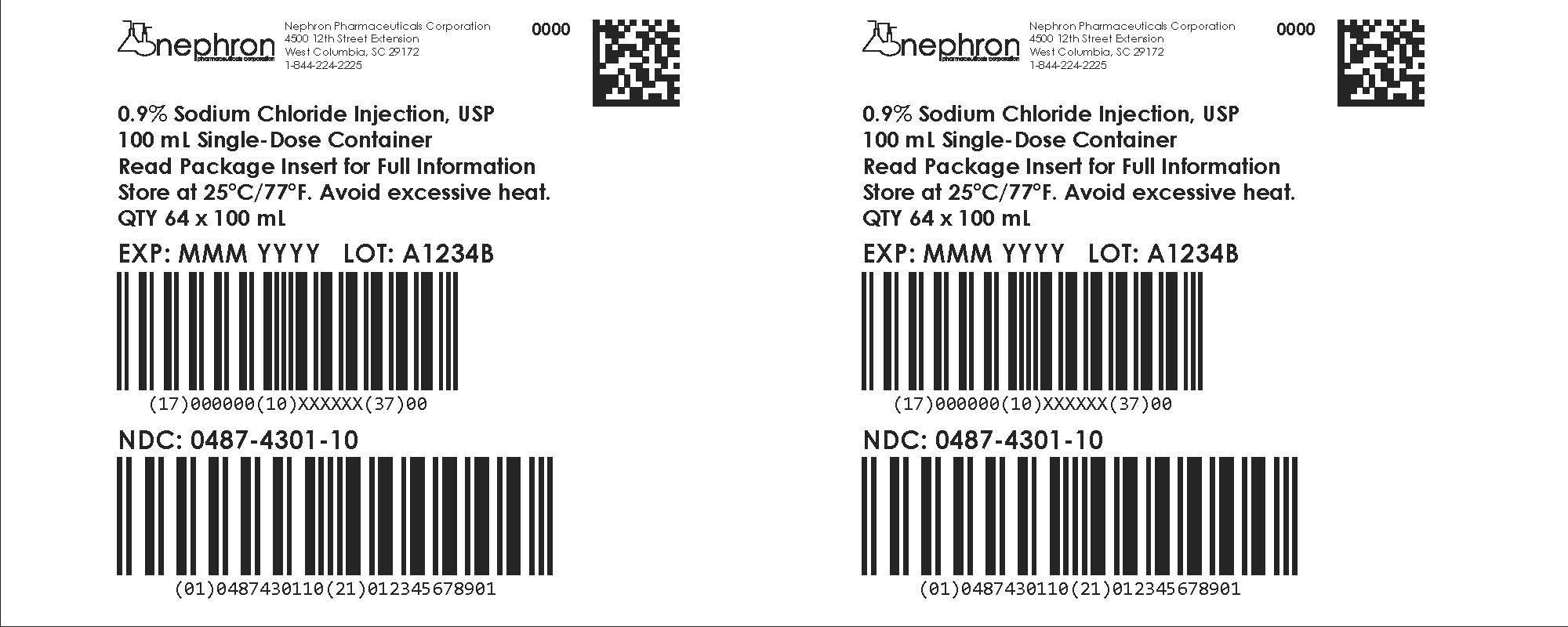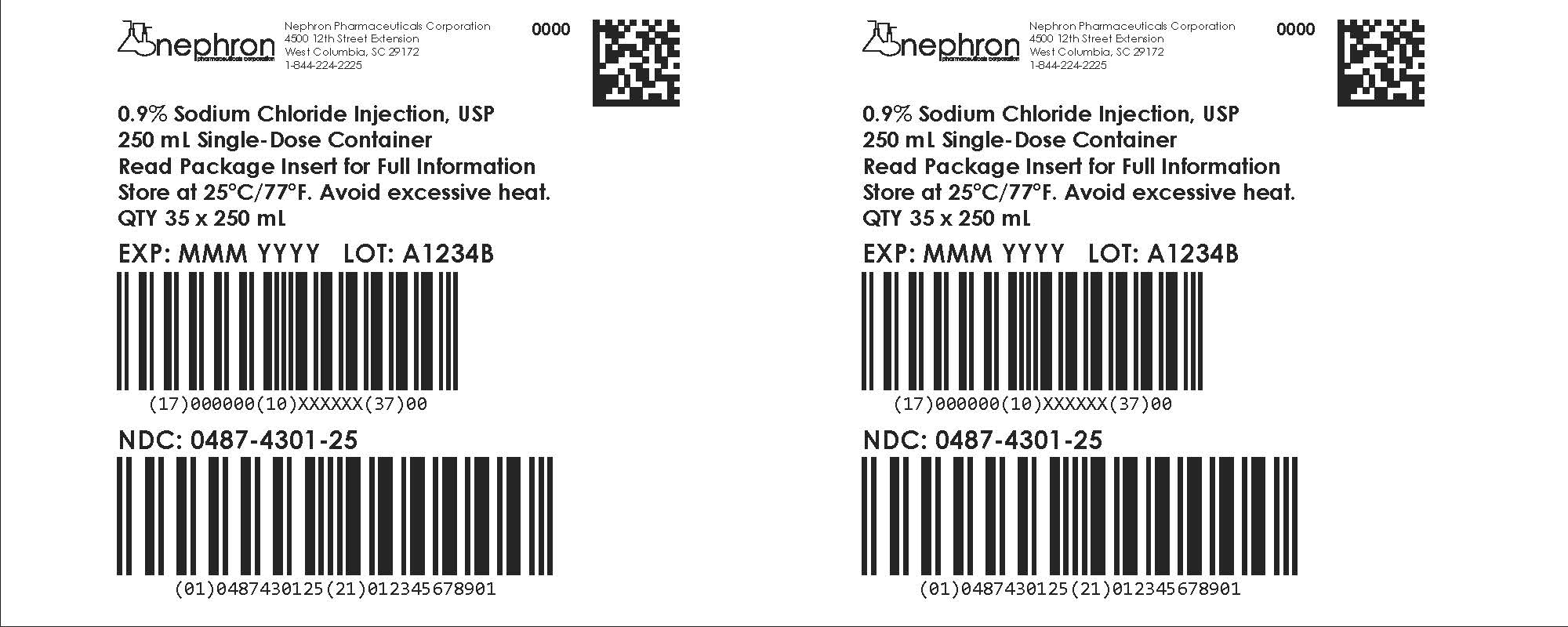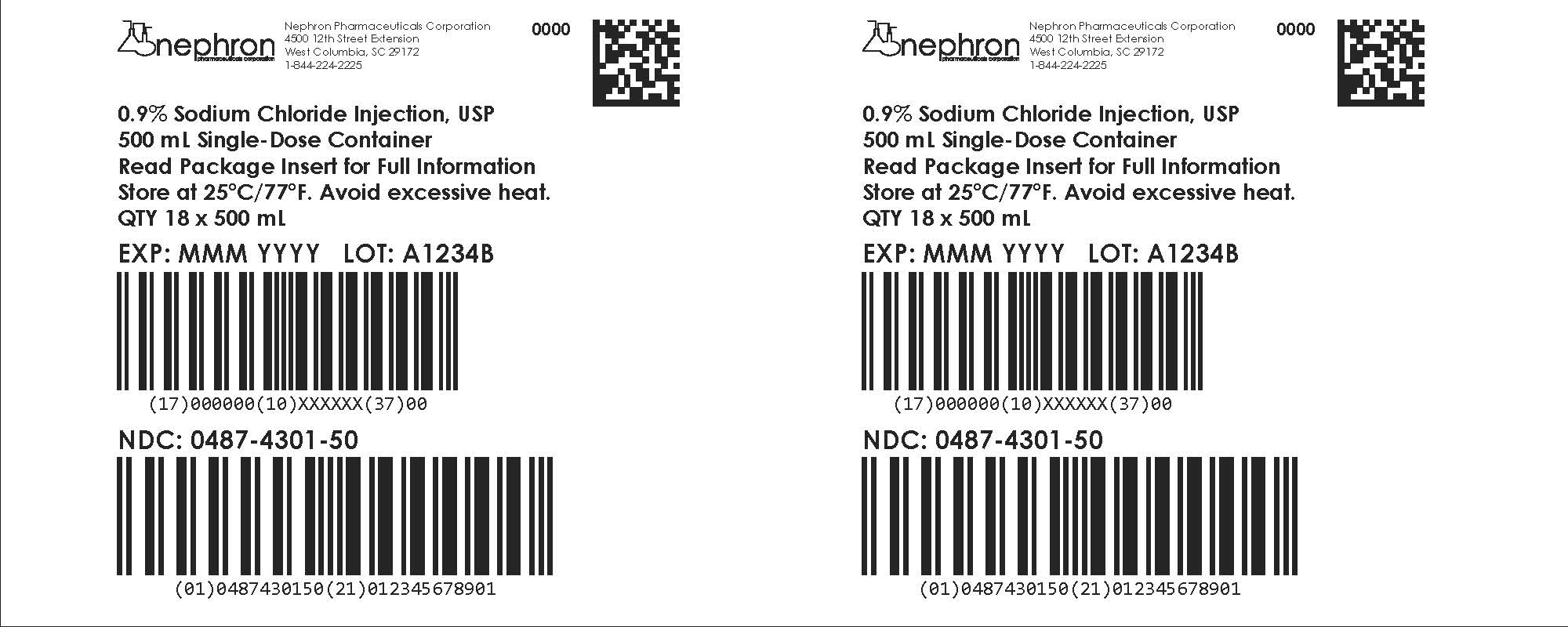DESCRIPTION
Sodium Chloride Injection, USP is a sterile, nonpyrogenic solution for fluid and electrolyte replenishment in single dose containers for intravenous administration. It contains no antimicrobial agents. The nominal pH is 5.6 (4.5 to 7.0). Composition, osmolarity, and ionic concentration are shown below:
0.9% Sodium Chloride Injection, USP contains 9 g/L Sodium Chloride, USP (NaCl) with an osmolarity of 308 mOsmol/L (calc). It contains 154 mEq/L sodium and 154 mEq/L chloride.
The plastic container is not made with PVC or DEHP.
The plastic container is made of polypropylene formulated and developed for parenteral drugs. The suitability of the plastic container has been established through biological evaluations, which have shown the container passes Class VI testing as specified in the U.S. Pharmacopeia for Biological Tests — Plastic Containers. These tests confirm the biological safety of the container closure system.
The container has two ports, one is for the intravenous administration set and the other is a medication addition site. Refer to the Directions for Use of the container to properly identify the ports.
No vapor barrier is necessary.
CLINICAL PHARMACOLOGY
Sodium Chloride Injection, USP has value as a source of water and electrolytes. It is capable of inducing diuresis depending on the clinical condition of the patient.
INDICATIONS AND USAGE
Sodium Chloride Injection, USP is indicated as a source of water and electrolytes.
0.9% Sodium Chloride Injection, USP is also indicated for use as a priming solution in hemodialysis procedures.
WARNINGS
Hypersensitivity
Hypersensitivity and infusion reactions, including hypotension, pyrexia, tremor, chills, urticaria, rash, and pruritus have been reported with 0.9% Sodium Chloride Injection, USP.
Stop the infusion immediately if signs or symptoms of a hypersensitivity reaction develop, such as tachycardia, chest pain, dyspnea and flushing. Appropriate therapeutic countermeasures must be instituted as clinically indicated.
Electrolyte Imbalances
Fluid Overload
Depending on the volume and rate of infusion, and the patient’s underlying clinical condition, intravenous administration of Sodium Chloride Injection, USP can cause fluid disturbances such as overhydration/ hypervolemia and congested states, including pulmonary congestion and edema.
Avoid 0.9% Sodium Chloride Injection, USP in patients with or at risk for fluid and/or solute overloading. If use cannot be avoided, monitor fluid balance, electrolyte concentrations, and acid base balance, as needed and especially during prolonged use.
Hyponatremia
Sodium Chloride Injection, USP may cause hyponatremia. Hyponatremia can lead to acute hyponatremic encephalopathy characterized by headache, nausea, seizures, lethargy, and vomiting. Patients with brain edema are at particular risk of severe, irreversible and life-threatening brain injury.
The risk of hospital-acquired hyponatremia is increased in patients with cardiac or pulmonary failure, and in patients with non-osmotic vasopressin release (including SIADH) treated with high volume of Sodium Chloride Injection, USP.
The risk for hyponatremia is increased in pediatric patients, elderly patients, postoperative patients, those with psychogenic polydipsia, and in patients treated with medications that increase the risk of hyponatremia (such as diuretics, certain antiepileptic and psychotropic medications). See
DRUG INTERACTIONS .
Patients at increased risk for developing complications of hyponatremia such as hyponatremic encephalopathy, include pediatric patients, women (in particular pre-menopausal women), patients with hypoxemia, and patients with underlying central nervous system disease. Avoid Sodium Chloride Injection, USP in patients with or at risk for hyponatremia. If use cannot be avoided, monitor serum sodium concentrations.
Rapid correction of hyponatremia is potentially dangerous with risk of serious neurologic complications. Brain adaptations reducing risk of cerebral edema make the brain vulnerable to injury when chronic hyponatremia is too rapidly corrected, which is known as osmotic demyelination syndrome (ODS). To avoid complications, monitor serum sodium and chloride concentrations, fluid status, acid-base balance, and signs of neurologic complications.
Hypernatremia
Hypernatremia may occur with Sodium Chloride Injection, USP. Conditions that may increase the risk of hypernatremia, fluid overload and edema (central and peripheral), include patients with: primary hyperaldosteronism; secondary hyperaldosteronism associated with, for example, hypertension, congestive heart failure, liver disease (including cirrhosis), renal disease (including renal artery stenosis, nephrosclerosis); and pre-eclampsia.
Certain medications, such as corticosteroids or corticotropin, may also increase risk of sodium and fluid retention, see
DRUG INTERACTIONS .
Avoid Sodium Chloride Injection, USP in patients with, or at risk for, hypernatremia. If use cannot be avoided, monitor serum sodium concentrations.
Rapid correction of hypernatremia is potentially dangerous with risk of serious neurologic complications. Excessively rapid correction of hypernatremia is also associated with a risk for serious neurologic complications such as osmotic demyelination syndrome (ODS) with risk of seizures and cerebral edema.
PRECAUTIONS
Patients with Severe Renal Impairment
Administration of Sodium Chloride Injection, USP in patients with or at risk of severe renal impairment, may result in hypernatremia and/or fluid overload (see WARNINGS ). Avoid Sodium Chloride Injection, USP in patients with severe renal impairment or conditions that may cause sodium and/or potassium retention, fluid overload, or edema. If use cannot be avoided, monitor patients with severe renal impairment for development of these adverse reactions.
Drug Interactions
Other Products that Affect Fluid and/or Electrolyte Balance
Administration of Sodium Chloride Injection, USP to patients treated concomitantly with drugs associated with sodium and fluid retention may increase the risk of hypernatremia and volume overload. Avoid use of Sodium Chloride Injection, USP in patients receiving such products, such as corticosteroids or corticotropin. If use cannot be avoided, monitor serum electrolytes, fluid balance and acid-base balance.
Lithium
Renal sodium and lithium clearance may be decreased during administration of 0.45% Sodium Chloride Injection, USP. Monitor serum lithium concentrations during concomitant use.
Renal sodium and lithium clearance may be increased during administration of 0.9% Sodium Chloride Injection, USP. Monitor serum lithium concentrations during concomitant use.
Other Drugs that Increase the Risk of Hyponatremia
Administration of Sodium Chloride Injection, USP in patients treated concomitantly with medications associated with hyponatremia may increase the risk of developing hyponatremia.
Avoid use of Sodium Chloride Injection, USP in patients receiving products, such as diuretics, and certain antiepileptic and psychotropic medications. Drugs that increase the vasopressin effect reduce renal electrolyte free water excretion and may also increase the risk of hyponatremia following treatment with intravenous fluids. If use cannot be avoided, monitor serum sodium concentrations.
Pregnancy
There are no adequate and well controlled studies with Sodium Chloride Injection, USP in pregnant women and animal reproduction studies have not been conducted with this drug. Therefore, it is not known whether Sodium Chloride Injection, USP can cause fetal harm when administered to a pregnant woman. Sodium Chloride Injection, USP should be given during pregnancy only if the potential benefit justifies the potential risk to the fetus.
Nursing Mothers
It is not known whether this drug is present in human milk. Because many drugs are present in human milk, caution should be exercised when Sodium Chloride Injection, USP is administered to a nursing woman.
Pediatric Use
The use of Sodium Chloride Injection, USP in pediatric patients is based on clinical practice. (See DOSAGE AND ADMINISTRATION ).
Closely monitor plasma electrolyte concentrations in pediatric patients who may have impaired ability to regulate fluids and electrolytes. In very low birth weight infants, excessive or rapid administration of Sodium Chloride Injection, USP may result in increased serum osmolality and risk of intracerebral hemorrhage.
Children (including neonates and older children) are at increased risk of developing hyponatremia as well as for developing hyponatremic encephalopathy.
Geriatric Use
Geriatric patients are at increased risk of developing electrolyte imbalances. Sodium Chloride Injection, USP is known to be substantially excreted by the kidney, and the risk of toxic reactions to this drug may be greater in patients with impaired renal function. Therefore, dose selection for an elderly patient should be cautious, usually starting at the low end of the dosing range, reflecting the greater frequency of decreased hepatic, renal, or cardiac function, and of concomitant disease or other drug therapy. Consider monitoring renal function in elderly patients.
ADVERSE REACTIONS
Post-Marketing Adverse Reactions
The following adverse reactions have been identified during postapproval use of Sodium Chloride Injection, USP. Because these reactions are reported voluntarily from a population of uncertain size, it is not always possible to reliably estimate their frequency or establish a causal relationship to drug exposure.
The following adverse reactions have been reported in the post-marketing experience during use of Sodium Chloride Injection, USP and include the following:
General disorders and administration site conditions : Infusion site erythema, injection site streaking, burning sensation, and infusion site urticaria
Hypersensitivity reactions : Hypotension, pyrexia, tremor, chills, urticaria, rash, and pruritus.
Metabolism and nutrition disorders : Hypernatremia*, hyponatremia, hyperchloremic metabolic acidosis.
Nervous System Disorders : Hyponatremic encephalopathy
*Adverse reaction of hyponatremia is only related to 0.9% Sodium Chloride Injection, USP.
If an adverse reaction does occur, discontinue the infusion, evaluate the patient, institute appropriate therapeutic countermeasures and save the remainder of the fluid for examination if deemed necessary.
OVERDOSAGE
Excessive administration of:
- 0.9% Sodium Chloride Injection, USP can cause hypernatremia.
- Sodium Chloride Injection, USP can cause fluid overload (which can lead to pulmonary and/or peripheral edema). See WARNINGS and ADVERSE REACTIONS .
When assessing an overdose, any additives in the solution must also be considered. The effects of an overdose may require immediate medical attention and treatment.
Interventions include discontinuation of Sodium Chloride Injection, USP administration, dose reduction, and other measures as indicated for the specific clinical constellation (e.g., monitoring of fluid balance, electrolyte concentrations and acid base balance).
DOSAGE AND ADMINISTRATION
Important Administration Instructions
- Sodium Chloride Injection, USP is intended for intravenous administration using sterile equipment.
- Do not connect flexible plastic containers in series in order to avoid air embolism due to possible residual air contained in the primary container.
- Set the vent to the closed position on a vented intravenous administration set to prevent air embolism.
- Use a dedicated line without any connections to avoid air embolism.
- Do not pressurize intravenous solutions contained in flexible plastic containers to increase flow rates in order to avoid air embolism due to incomplete evacuation of residual air in the container.
- Prior to infusion, visually inspect the solution for particulate matter and discoloration.
- The solution should be clear and there should be no precipitates. Do not administer unless solution is clear, and container is undamaged.
Dosing Information
The choice of product, dosage, volume, rate, and duration of administration is dependent upon the age, weight and clinical condition of the patient and concomitant therapy, and administration should be determined by a physician experienced in intravenous fluid therapy.
Introduction of Additives
Additives may be incompatible.
Evaluate all additions to the plastic container for compatibility and stability of the resulting preparation. Consult with a pharmacist, if available.
If, in the informed judgment of the physician, it is deemed advisable to introduce additives, use aseptic technique. Mix thoroughly when additives have been introduced. After addition, if there is a discoloration and/or the appearance of precipitates, insoluble complexes or crystals, do not use. Do not store solutions containing additives. Discard any unused portion.
HOW SUPPLIED
The available sizes of 0.9% Sodium Chloride Injection, USP are shown below:
NDC 0487-4301-05 - 50 mL, 64 units per shipper
NDC 0487-4301-10 - 100 mL, 64 units per shipper
NDC 0487-4301-25 - 250 mL, 35 units per shipper
NDC 0487-4301-50 - 500 mL, 18 units per shipper
Exposure of pharmaceutical products to heat should be minimized. Avoid excessive heat. It is recommended the product be stored at room temperature (25° C/ 77° F); brief exposure up to 40° C/ 104°F does not adversely affect the product.
DIRECTIONS FOR USE
For Information on Risk of Air Embolism - see DOSAGE AND ADMINISTRATION .
Inspection Before Preparation for Administration
Visually inspect the container. If the outlet port protector is damaged, detached, or not present, discard container as solution path sterility may be impaired. Check for minute leaks by squeezing bag firmly. If leaks are found, discard solution as sterility may be impaired. If supplemental medication is desired, follow directions below. Check solution for clarity and absence of foreign matter. If solution is not clear or contains foreign matter, discard the solution.
Preparation for Administration
- Suspend container from eyelet support.
- Remove plastic protector from outlet port at bottom of container.
- Grip the small wing on the neck of the port with one hand.
- Grip the large wing on the cap with the other hand and twist.
- The cap will pop off.
3. Attach administration set. Refer to complete directions accompanying set.
To add medication before solution administration
- Remove additive port closure: hold container below additive port and grasp cap between thumb and forefinger then flip cap upward. Swab exposed additive port using aseptic technique.
- Using syringe with 19 to 22 gauge needle, puncture resealable medication port and inject.
- Mix solution and medication thoroughly. For high density medication such as potassium chloride, squeeze ports while ports are upright and mix thoroughly.
To add medication during solution administration
- Close clamp on the set.
- Prepare medication site.
- Using syringe with 19 to 22 gauge needle, puncture resealable medication port and inject.
- Remove container from IV pole and/or turn to an upright position.
- Evacuate both ports by squeezing them while container is in the upright position.
- Mix solution and medication thoroughly.
- Return container to in-use position and continue administration.
